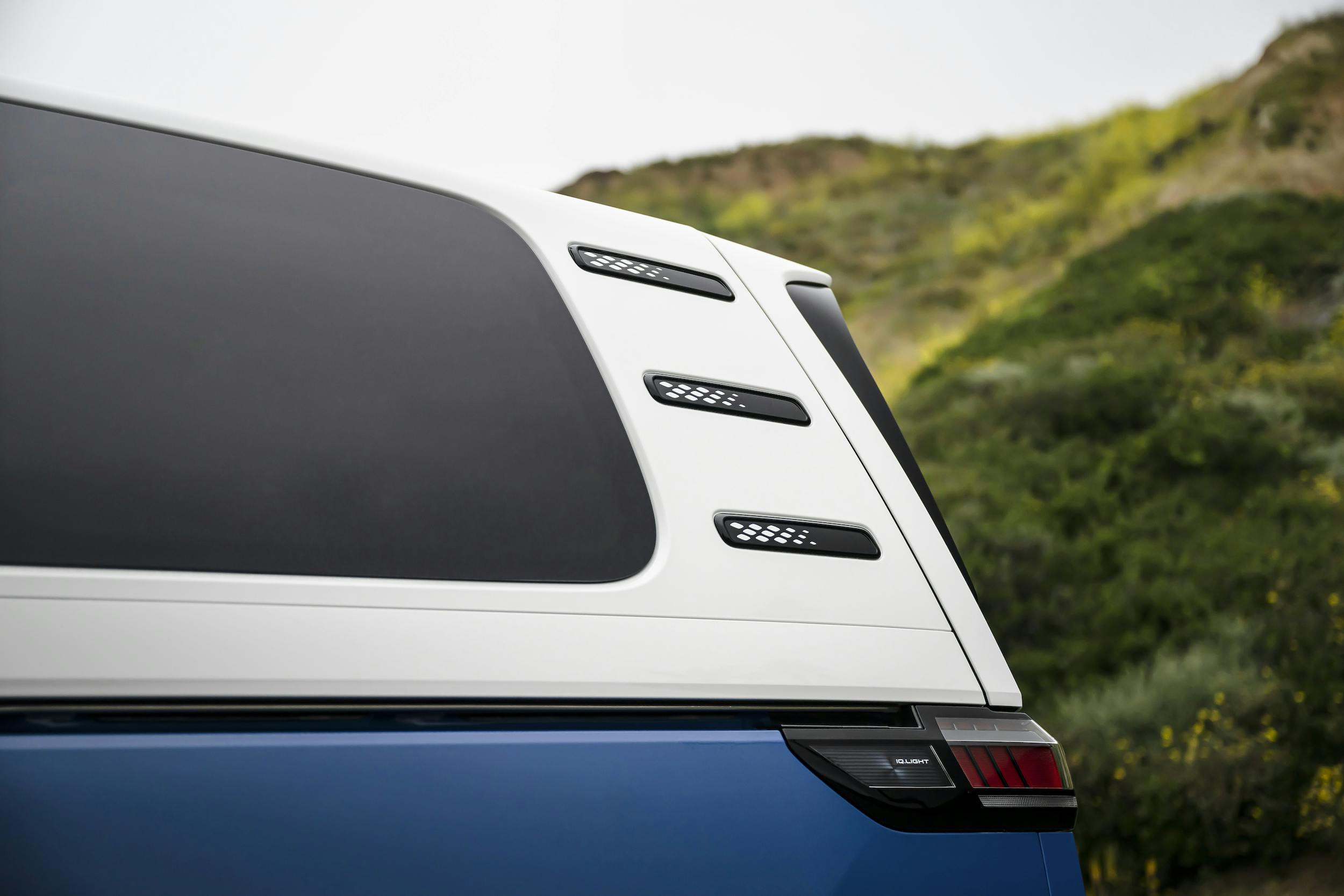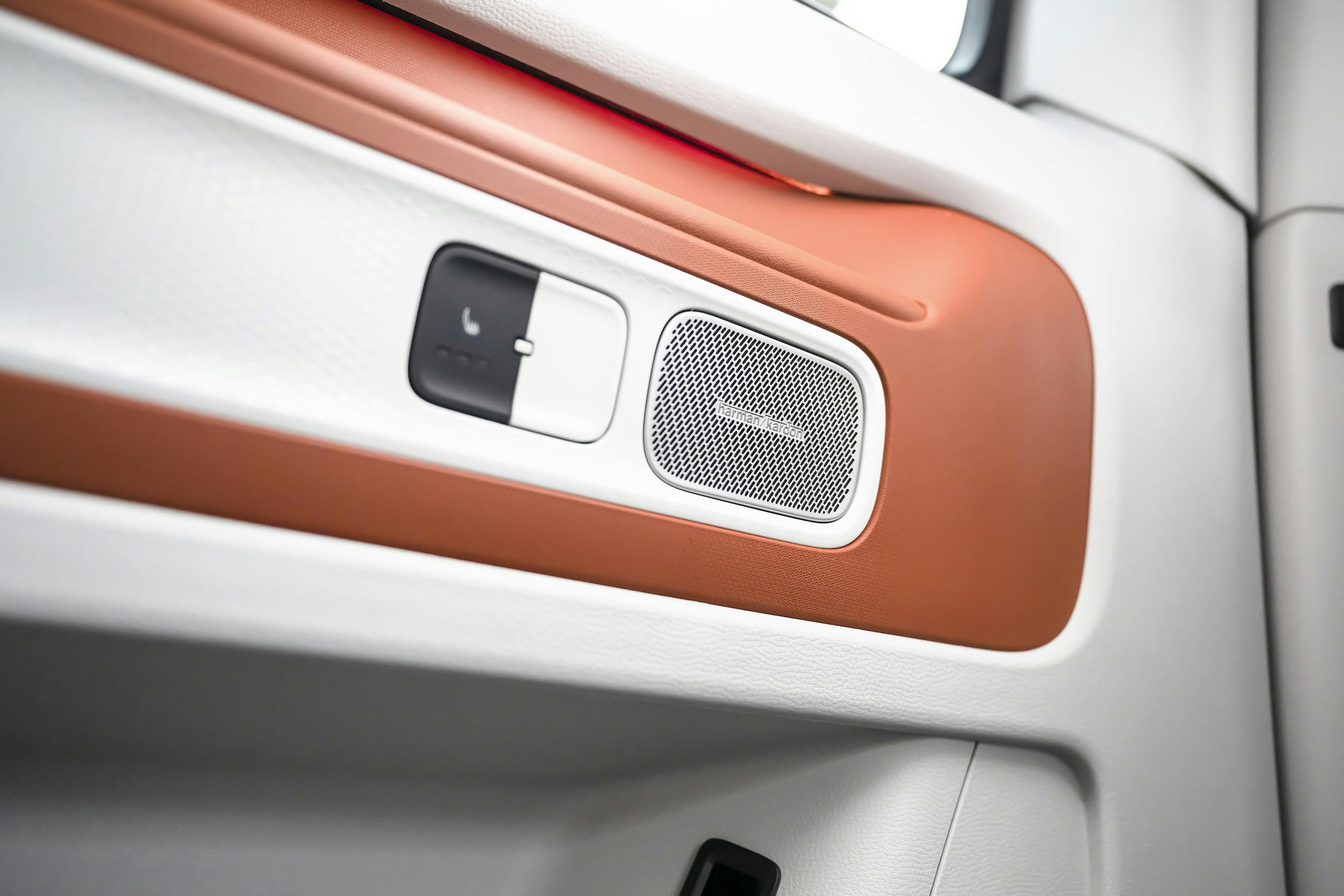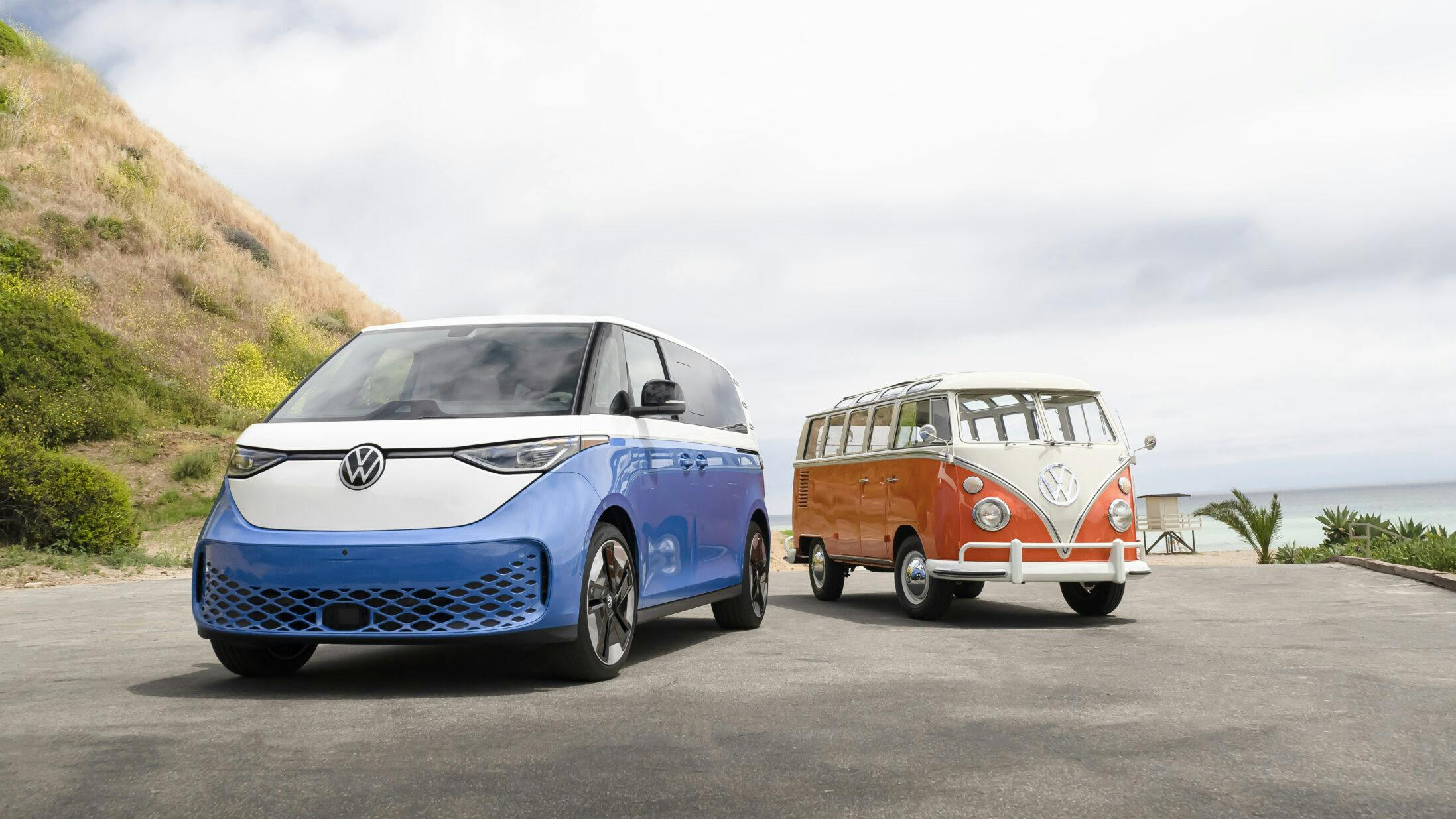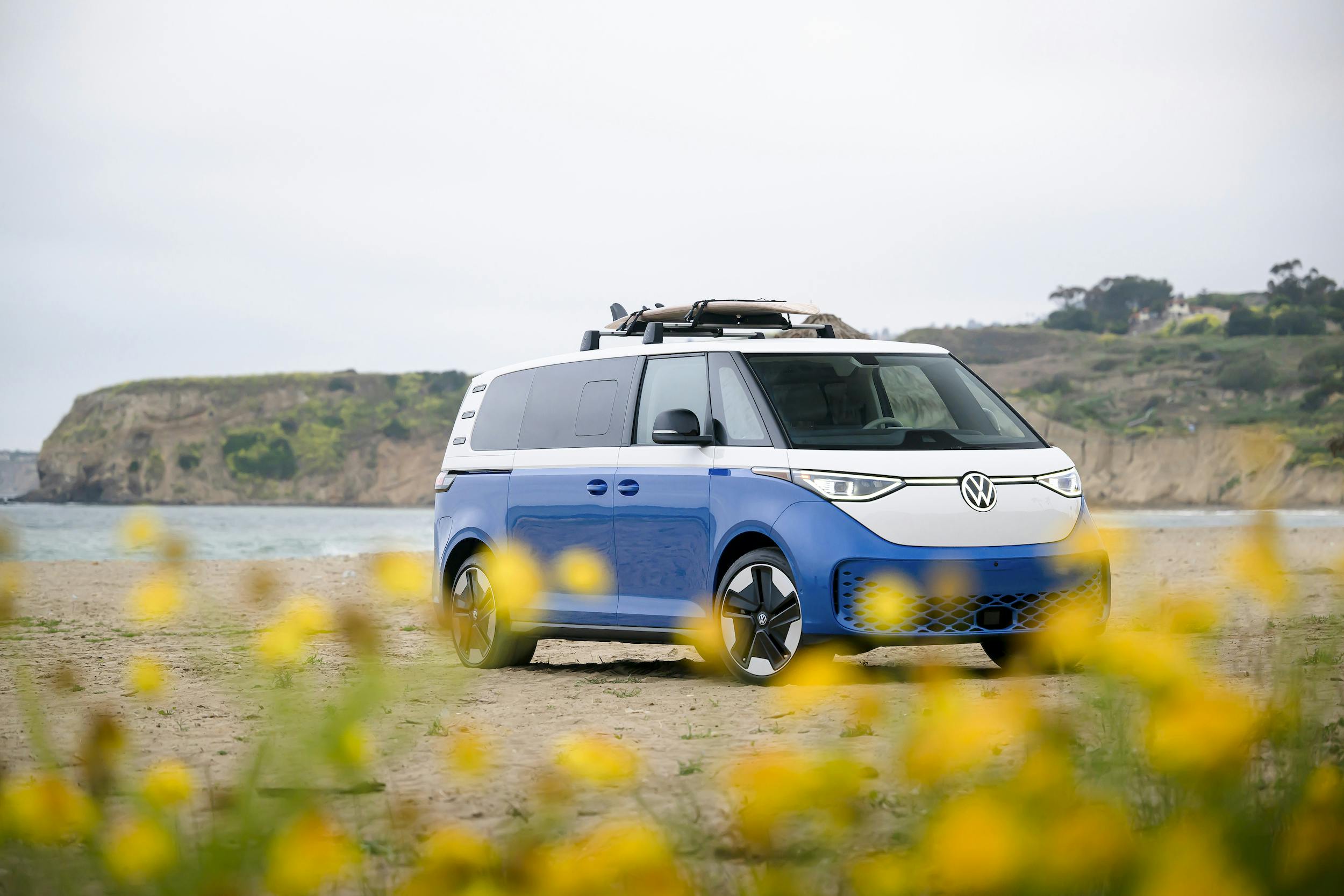Media | Articles
23 years after VW’s first Microbus tease, we get the real thing
In what may be the longest journey yet from auto-show concept vehicle to actual production, the Volkswagen ID. Buzz is scheduled to arrive in 2024.
Finally. That journey began in January of 2001 with the debut of the Volkswagen Microbus concept at the North American International Auto Show in Detroit, then resurfaced years later with the debut of the undeniably familiar VW ID. Buzz at the Detroit show. Three years after the two-row Buzz went on sale in Europe, the United States will be getting our own three-row version of the minivan . . . sometime next year.

It all began when VW was riding high on the revival of the New Beetle in 1998. Might a little nostalgia work in the minivan world? The bread loaf–shaped Microbus wasn’t at all that Micro, what with three rows of seats, and it didn’t look much like the original hippie-beloved Microbus, but was still one of the stars of the Detroit show in 2001. VW even passed out cards, attached to lanyards, that read, “I’ve seen the bus!”
Marketplace
Buy and sell classics with confidence
Showgoers thought they’d see the Microbus again in 2005 or so, after VW announced in 2002 that it was probably headed for production. But Volkswagen chickened out, and instead badged a version of Chrysler’s minivan as the Volkswagen Routan. And that was that.

Until January of 2017, anyway, when—16 years, almost to the day, since the debut of the VW Microbus concept—the Volkswagen ID. Buzz showed up on the Detroit show floor, looking quite a bit like it does now. Still three rows, but this time fully electric. The production version premiered this week at a press event in—where else?—Southern California.
It’s come a long way from 2017, an even longer distance from 2001.

So what are we getting in 2024, then? “Retro design cues, like the oversized VW logo, short overhangs, and available two-tone color palette,” all of which match that 2001 prototype, “meet a tailored interior, cutting-edge EV technology, and advanced driver assistance features, clearly marking it as a vehicle of the future,” VW says.
“The zero-direct emission ID. Buzz is the spiritual reincarnation of the Microbus, reimagined for our electric future,” said Pablo Di Si, president and CEO of Volkswagen of America. “It is practical, sustainable, and packaged in an unmistakably fun way that is classic Volkswagen. With its launch, the Bus will once again become our brand hero in America.”

Just as with the original Bus, the three-row ID. Buzz has a rear-mounted powerplant as standard. That rear motor produces 282 horsepower, in comparison to the two-row European-spec model, which debuted with 201. The battery is also larger, at 91 rather than 82 kWh. The skateboard design, with the battery mounted in the floor, saves space and contributes to better handling by locating a large percentage of the vehicle’s weight down low.
All-wheel drive is available for the ID. Buzz at launch, in a configuration boasting about 330 hp from the dual motors. Top speed is electronically limited to 99 mph.
Outside, the ID. Buzz retains its traditionally boxy shape with those short overhangs, “giving it maximum utility on a minimal footprint.” It is 192.4 inches in length, nearly 10 inches longer than the two-row Buzz; all that additional length comes from a 127.5-inch wheelbase, versus 117.6 inches for the two-row. It is 77.9 inches wide and 74.6 inches tall, making it roughly as wide as the VW Atlas, but five inches taller. “Given that the original Bus was about as long as a 2019 Beetle and slightly narrower, this is a sizable increase,” VW notes. The coefficient of drag is just 0.29, good for a minivan.

“Retro cues throughout are a throwback to the original Bus, while reinterpreting the design for the future.” The iconic oversized VW logo is illuminated, with a light line that extends to either side, connecting to the LED headlights. “Bold exterior colors, with an available two-tone color palette, include many found on the two-row ID. Buzz such as Energetic Orange, Pomelo Yellow and Mahi Green, for example. Others, such as Cabana Blue, Metro Silver, and Indium Grey, are all-new.”
Dual power-sliding rear doors with “Easy Open and Close” provide good access to the third row and are replete with a modern take on the classic sliding windows—also fully powered. The bus also features standard power-folding and heated side mirrors, plus a standard power tailgate.
On the D-pillar, air “vents” recall the original Bus’s rear-engine cooling slots. Wheels are aerodynamically optimized 20-inchers.
Inside, “attention has been paid to every detail—from the retro-inspired wood-optic dash to the whimsical ‘Play and Pause’ pedals from the 2016 Buzz concept.”
The removable center console includes flexible storage on top, with two unique dividers that double as a bottle opener and ice scraper, as well as two additional compartments below. Ambient lighting with 30 colors is standard, and allows drivers to select from five preset moods, or choose to differentiate areas individually. The greenhouse can be further enhanced by an available panoramic glass sunroof with electrochromic tinting, which changes from clear to opaque with the swipe of a finger.
In addition to perforated leatherette seating, all Buzz models are equipped with standard 12-way power driver and passenger seats with dual armrests, ventilation, massage, and memory functions; front seats and outboard second-row seats are heated.
Seating for seven is standard, and captain’s chairs are available with seating for six. The second and third rows fold flat, and the third row can be removed entirely. An available Flexboard, with two fabric storage bins, creates a flat floor with the seats folded.
The available Harman Kardon premium audio system has 14 speakers; nine speakers are standard.
In the cockpit, drivers are presented with two screens: A 5.3-inch one sits behind the steering wheel, next to the 12.9-inch central infotainment display. The Buzz makes it easy to connect devices with standard wireless App-Connect and wireless charging. Passengers had better stock up on their USB-C charging cables, because the Buzz has only the one kind—and eight of them. A 110-volt outlet is under the passenger seat, and 12-volt charging sits in the cargo area.
The Buzz also comes with the ID. Light system—a light strip that runs below the windshield and provides the driver with “intuitive support.” It uses various light pulses to signal status such as readiness to drive, turn instructions from the navigation system, brake prompts from driver-assistance systems, and incoming phone calls. When using voice commands, it signals that it is listening, similar to voice-activation on mobile phones or virtual assistants. When the ID. Buzz is plugged in to charge, the ID. Light indicates the current level of charge.

IQ.DRIVE driver assistance technology, featuring hands-on Level 2 ready capability, is standard in the ID. Buzz. On the highway, IQ.DRIVE features lane centering and a capacitive steering wheel to help make driving easier. Around town, IQ.DRIVE helps alert you to obstacles in front of you, and keeps an eye around you to help make driving safer. Dynamic Road Sign Display is standard as well, and a head-up display, Park Assist with remote parking, and Area View are available features.
A long time coming, and lots of technology updates between 2001 and 2024. But it’s proof that a good idea is a good idea, regardless of the decade.
***
Check out the Hagerty Media homepage so you don’t miss a single story, or better yet, bookmark it. To get our best stories delivered right to your inbox, subscribe to our newsletters.


























































Does it have a volume knob and non-touch HVAC controls? Can you get cloth seats? Will a 4×8 sheet of plywood or drywall fit in the back if you remove all the seats? Is there a 2″ hitch available from the factory for bike racks or very light towing? These are questions that non-soccer moms who are shopping minivans are going to ask. The correct answer to all is YES. How well will VW do on this test?
Yuppppp. All this. Honestly, if it’s missing any of those, I’m out. Gimme a hybrid Toyota Sienna with AWD all day, every day.
Also, no stow-n-go rear seats is also a dealbreaker for me.
Did VW mention range? And with 330 hp, why limit it to 99 mph? Will the prospective buyers be proud of the effect on the planet involved with the manufacturing process? When electricity oozes out of ground like oil, then EV’s will be the logical choice.
100% correct!
I mean, it comes out of the sky and needs a lot less processing and refining…
No thanks. I’d rather have the “ancient” air cooled one.
It’s a minivan with a two tone paint job, period. Square, ugly and of no resemblance to the original.
I remember way back then, my wife and I said that if they made that Microbus concept, that would be the first (and probably only) minivan we’d own. We waited and hoped and hoped and waited. Eventually, we moved on. It certainly wasn’t the first time, and not the last.
I agree with Steven Cole Smith that this is probably the longest concept-to-production time in automotive history. It beats out the Bronco by a few years.
I should add that as this isn’t the Microbus teased back in 2001, we have no plans to make it our first minivan. We were expecting a two-row, ICE-powered, less-expensive rendition. Plus, the original concept is a little better looking. The front end of the production model needs a little more love.
Here is a thought of a different kind. Why not limit the places an EV can stop within. An EV would be prohibited from recharging in an area that has coal fired power plants. An EV would be free to stop and charge in an area deriving power from the wind. Somebody in a higher pay grade would have to tell me about nuclear plants. I know they are basically clean, however when things go wrong, you can only hope there is enough charge left to get the hell away, far away. Just an old man’s silly thought.
Won’t lie – I wouldn’t mind seeing the short-wheelbase version with dual motors and the juice turned up. Give it an R badge.
Yeah yeah VW. This is weird. Retro looks but electric powered. I’ll wait in vain for a petrol or hybrid powered Westy version with more analog controls. That way, I could have a true retro experience, and take it on a cross country tour without the associated electric travel hassles. It would make way more sense to put modern styling on it, and not pretend it is something it isn’t. This is strictly for trendy urban soccer parents imho. Maybe that was their goal. I’m dissapointed.
we’ll have to copy it and put in an ls motor with awd. think 92 astro van running gear.
I drove one at the VW Factory in August 2023. It’s an electric SUV with the windshield pushed way out front.
It’s easy to drive but use of interior space is not what one would expect in a van. About 1/3 of that space is the enormous dash and front seat area. As for the rest … think SUV, not van.